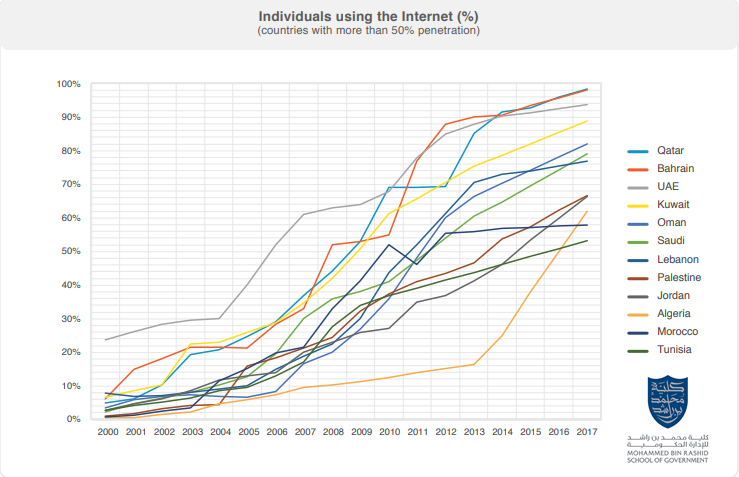The Arab World Online 2017 | MBRSG and Bayt.com
| Middle East
The study conducted by MBR School of Government revealed that by 2021, it is predicted that 47 million new internet users, 45 million new mobile broadband users and around 160 million new social media users will come online in the Arab region. Many of the transformations are changing how societies in the region interact, how economies move and how governments deliver services, develop policies, interact with the public and address challenges of development in the digital age.
Without further ado, here are the crucial data reflects the key societal statistics and ramifications of the 4th industrial revolution in the Arab World:
Connectivity and ICT Adoption in the Arab Region in 2017
- In 2017, internet penetration in the Arab region reached 42% and it’s estimated to reach 49% by 2020.
- There were about 173 million internet users in the Arab region in 2017, and it’s expected to exceed 208 million by 2020.
- Mobile phone penetration rates in the Arab world has exceeded 101% in 2017, and the number of mobile subscriptions has also exceeded 420 million and it’s estimated to surpass 435 million subscriptions by 2020.
- Egypt held the highest number of mobile subscriptions in the Arab World in 2017 which accounted for almost 90 million, followed by Saudi Arabia (+52 million) and Algeria (+51 million).

A Graph Shows the Percentages of Individuals Using the Internet in 12 Countries of the Arab World – 2017
Average Time Spent Online in the Arab World in 2017
- Smartphone is the most used device to access the internet for the majority of Arab users, with an average of 4:58 hours spent online daily using such devices.
- There are 17.3% of respondents spend more than 10 hours online through their phones on daily basis.
- Over 7 out of 10 of respondents in the Arab region spend 2 or more hours online on their internet-connected phones, compared to 47% who spend the same time using their computers (laptops and desktops).
Online Trends and Behaviors in the Arab World in 2017
- Arabic is the most used language for 58% of respondents who prefer to browse or consume content online, followed by the English language with a rate of 32% and French with only 9%.
- 69% of internet users in the Arab world indicated that they have increased their time spend online today compared to two years ago, while 63% indicated that they’ve increased their online news consumption also.
- 37% of internet users in the Arab world claimed that they’ve increased their online spending over the internet today compared to two years ago.
The Use of Mobile Apps in the Arab Region in 2017
- In terms of using mobile apps in the Arab World, the smartphone users in the Arab region use an average of 12 apps on regular basis.
- Social media apps are the most used apps with a rate of 98.4%, followed by messaging apps (91.4%), content\educational apps (55.3%) and multimedia apps (54.7%).
- WhatsApp (89%) and Facebook Messenger (74%) are the two most used instant messaging apps by internet users in the Arab region. Snapchat comes far in third place with 22% of users.
- In general, 84% of internet users in the region said that they use voice or video calling apps. 27.3% of them use WhatsApp calls and 64% use FB Messenger calls.
- Just 36% of internet users in the Arab use one or more sharing economy services apps. 52% of them use Car Sharing Apps (Careem, Uber, etc.).
- Among car-sharing applications, Uber and Careem are the most popular in the region with rates of 45% and 38%, respectively.
- Over 96% of users reported they personally experienced a positive impact out of sharing apps thanks to saving time (55%) saving money (33%).

A Graph Shows the Average Number of Apps Used Regularly on Smartphones in the Arab Region in 2017
Methodology:
Data is based on an online survey was administered in 22 Arab countries during the third quarter of 2017. The respondents were proportionally represented according to the internet users’ breakdowns in all countries in the Arab region (Algeria, Bahrain, Comoros, Djibouti, Egypt, Iraq, Jordan, Kuwait, Lebanon, Libya, Mauritania, Morocco, Oman, Palestine, Qatar, Saudi Arabia, Sudan, Syria, Tunisia, UAE, and Yemen).
Overall, 19,869 people took the survey. Out of those, a total of 9,701 completed all questions, including optional ones, with a response rate of around 50%. Around 25% of respondents were female and 75% were male.






